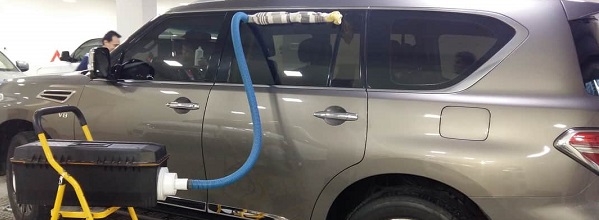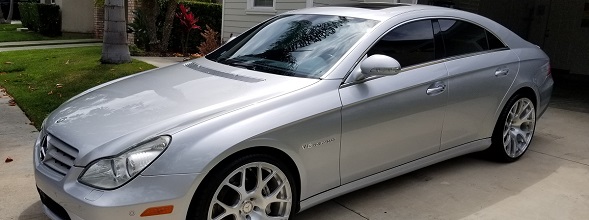
Preserve your car’s value by making an appointment today for auto detailing.
exterior & interior detailing : odor removal : paint sealant
#1 Mobile Car Detailing San Diego
The Ultimate Lease Return Checklist
When leasing a vehicle, you’re agreeing to make regular payments – follow a scheduled maintenance plan, and keep the car the duration of the agreement.
One of the merits of leasing vehicle is the flexibility it offers at the end of the lease term. As a lessee, you can opt to buy out your current leased car, lease another vehicle, or return the vehicle and walk away.
Whether you want to sell your vehicle or to make lease return, it needs to appear clean and maintained. To score the best marks at lease inspection, you need to have the car professionally detailed.
Lease Return Inspection
Most manufacturers require you to schedule a lease inspection 90 days before you turn in your leased car. The intent is to ensure that the vehicle is in good condition before it is returned and to inform you know what if any lease-end penalties will be assessed.
The carmaker will reach out to you to arrange for a third-party inspector to come to your office or home. The inspector will provide you with a copy of their report, and you will get the option to fix any damage yourself or pay the applicable charges. There’s no charge to the consumer for the lease inspection.
Prior to an inspection, experts recommend removing all personal items and detailing the vehicle. You don’t have to spend hundreds, but a car detailing will be a great solution. It’s definitely to your advantage to return your vehicle in the best light you can.
It Includes?
Lease inspectors are hunting for any damage beyond standard wear and tear. They’ll typically inspect:
- Tires with less than 1/8-inch of tread remaining;
- Heavily dented wheels;
- Dents, scratches, and gouges bigger than 2”;
- Improperly completed body repair work;
- More than three dongs on single body panel;
- Windshield chips larger than 1/8”;
- Upholstery tears or burns;
- Excess carpet stains;
- Service indicator lights turned on.

Prepare for the Inspection
Whether you want to buy, lease, or walk away from it, your vehicle will need to undergo a thorough leasing return inspection. The car will be inspected for the mileage, wear and tear, and other issues that may reduce the value of the vehicle.
You should prepare for the end of lease inspection in advance by following these steps:
- Check the mileage – About three months before the end of the lease, check your mileage. Most 3-year contracts allow for 12,000 miles a year. By the time you turn in the vehicle, the mileage should be 36,000 or under. If you’re over the mileage cap, be ready to pay an extra fee per mile, for the miles’ number which is over the maximum miles permitted;
- Avoid increasing the mileage – If you think you might exceed the mileage cap by the time lease is over, cut down on driving the vehicle for a while. The excessive mileage penalties add up quite fast once you go over the mileage cap;
- Detail your car – Get the car detailed inside and out before you take it in for the lease inspection. Be very thorough and make your vehicle looks its best.
Detail the Vehicle Before Lease Return
Detailing is definitely your advantage to present your vehicle in the best light you can. Below is explained how auto detailer can help with returning a leased car in top condition.
Paint
Lessors list that the paint can’t have a scratch bigger than a credit card that’s through the paint finish. This means they don’t look for marring and swirls as much as they do significant, deep scratches. Therefore, if you have a deeper scratch, a detailer will eliminate or level the deeper scratches to make them less noticeable.
Whether you do full paint correction or just have certain focused areas fixed, this can prevent costly hourly dealership labor rates.
Next, lessors list any dent “greater than a credit card.” If you have any dents this big, or anything larger than a regular door ding, you can hire a detailer who offers paintless dent repair. This’s more than likely what the dealership will do anyway, and they’ll surely mark it up when you let them handle it at lease turn-in.
Interior
Any stain, reap, or tear bigger than a credit card is considered excessive interior wear. If you have any stains, then the car detailer will clean up this efficiently, again saving you possibly thousands on return.
Seats, carpets, dash, door panels, floor mats, and center console areas all are exposed to some sort of dirt every day. Detailing all interior surfaces regularly will prevent anything from sitting too long on any interior surface, doing irreversible damage.
CAR ODOR REMOVAL GUIDE
The most common, and the most challenging issue auto detailers face are car odor. Many folks clean vehicle interior with everyday household cleaning products, water, and the inevitable kitchen sponge …
MOBILE CAR DETAILING
Forget about jammed car wash stations and detailing workshops. Now, you can get the vehicle detailing anywhere you wish – at your driveway, home, or office – solution is in mobile car detailing.
Glass
No cracks or major rock chips can be present. But, not really much, you can do to prevent this from occurring. The lessors also specify that you can’t have any non-factory window tint on the car.
The leasing company will charge you dramatically high labor rates to remove the aftermarket tint. This’s something your detailer can also do, but for less money. While having the other components detailed, be sure to have them remove any tint added during the leasing.
Wheels
The last thing lease covers are the wheels. Wheels must have no scratches or gouges greater than one inch and must be in good shape. Wheels with damage may be quoted as needing a replacement at the time of the leasing return, and it could cost you thousands depending on the vehicle.
Many detailers have repair services for wheels with curb rash, and this may cost a few hundred bucks but won’t cost as much as an OEM replacement. Keeping wheels clean will prevent corrosion and pitting from the brake dust, which could also need replacement cost from the dealer.
What Charges May be Due at Lease Return?
Prospective lease end charges cover mileage overage, excess wear, late charges, and disposition fees. We’ll scrutinize each of them separately.
Mileage overage
Divide current mileage by the number of months you’ve had the car and then multiply that number by the number of months in the lease to estimate how many miles will be on the vehicle at lease end.
- Under-mileage: If the estimated mileage is under your allowance, you can just return the car at the end of the lease. If you purchased additional mileage (but didn’t use), this’s often refundable, but there’s no credit for being under the mileage in the lease agreement;
- Over-mileage: If the estimated mileage is over your allowance, you have 3 options—either arrange to drive the vehicle less, pay the mileage penalty at the end of the lease ($0.15-$0.30 per mile depending on the manufacturer) or buy the car at the end of the lease.
Excess wear
Leased vehicles must be returned in excellent shape to escape extra charges. It may be worthwhile to consider hiring a professional repair any dents or scratches before turning in the vehicle. If the tires (already mentioned) have less than 1/8-inch tread, they should be replaced to elude potentially costly tire replacement charges at the dealership.
Late charges
Every leased vehicle must be returned by the lease termination date on the agreement. The car can be returned to any dealer of the same brand. Some banks offer a small grace period of a few days, but beyond that, fees will start to accrue.
Disposition fee
A disposition fee is typically due when the leased vehicle is returned. It can be between $200 and $500 (the exact amount will be specified in the contract). Many carmakers will waive this charge if you lease another car with them.
5 Tips on How to Return the Leased Car
Here are 5 useful tips that will help you with lease returns.
1. Choose a dealership for the leasing return
Theoretically, you can return the leased car to any dealership of the same brand. But in the real world, you’ll find that some dealers might be skeptical about taking on an extra piece of inventory they hadn’t planned on.
If you want the best experience, go to the same dealership from which you bought the vehicle. If you’ve moved or the dealership is no longer in business, you’ll obviously have to choose another one. Call the used-car manager to set up an appointment for the return.
2. Fix damaged bumpers, bald tires, and broken windshields
Glass, bumpers, and tires are the three components that you’re always better at repairing yourself. If the tires are bald, you may be in the problem. This’s why it is a good reason to change the tires regularly.
Damaged bumpers are another common issue, and they can be costly. If you dislodge it, that’s a $900 replacement. Also, you’ll be charged for any equipment that doesn’t work adequately, including navigation systems, window regulators, radios, and so on. It’s a smart move to get these fixed beforehand so that you get an acceptable price on the repair.
Keep the receipts in order to document your repairs. If a taillight or headlight is scraped but not broken, you may pass a penalty fee. Still, the inspector won’t overlook a big crack in the windshield. It’s recommended to pay the $100 deductible and get your windshield repaired. If you don’t get it fixed, you’ll pay a lot for that negligence.

3. Check the lease policy
Every lease policy interprets differently, so it’s wise to read the fine print. Small stains, scratches, and dings are often considered to be legitimate wear-and-tear. Generally, you’re subject to the credit card test for lease damage. If the damage is a ding that can be covered via a standard credit card, you’re fine. Make sure you have this credit card test before you turn the vehicle.
For instance, some leasers won’t charge for body dents less than 1″ in diameter, while others won’t charge for cuts less than 4″ wide. However, if there’s a puncture in a body panel – you’ll be definitely charged for it.
4. Ensure your car gets scheduled maintenance
Keep a written record of the vehicle’s maintenance, to prove you changed the oil regularly, checked fluid levels, and rotate the tires. If you have engine trouble or other mechanical issues, your records will show that you were not at fault. Still, if your lease is no longer than three years, the car warranty should cover the cost of any necessary repairs.
5. Don’t exceed your annual mileage limits
Lease companies generally offer a range of mileage allowances. If you exceed your limit, again, you may be charged 15 to 30 cents per mile, depending on the lease. So, if your excess mileage amounts to 20,000 miles, you could be billed $2,500.
What Do I Need to Bring When Return the Car?
When you return the vehicle, bring the following items you received at the beginning of the agreement:
- A copy of your lease contract;
- Owner’s manual;
- Maintenance guide.
You also must return all original equipment, including keys, keyless entry remotes, electric vehicle charges/cables, DVD player headphones/remotes, cargo covers, convertible boot covers, etc.
Best Lease Return Expert in San Diego
Before returning your lease, send your vehicle to #1 San Diego car detailing leasing return doctor. Michael Dreebin will help you pass the vehicle return checklist test for your return. Call us, and we’ll came to your place and evaluate excess wear and use.
Afterward, we perform complete auto detailing to ensure you comply with the dealership’s leasing condition. If necessary, Michael will advise you on any repairs he thinks will better prepare you for a triumphant car return. For more information about lease return car detailing, call 760-822-6363.



